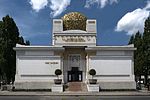Theater auf der Wieden
1787 establishments in Austria1801 disestablishments in AustriaBuildings and structures demolished in 1801Buildings and structures in WiedenDemolished buildings and structures in Austria ... and 5 more
Former theatres in ViennaMusic venues completed in 1787Opera houses in ViennaThe Magic FluteTheatres completed in 1787

The Theater auf der Wieden, also called the Freihaus-Theater auf der Wieden or the Wiednertheater, was a theater located in the then-suburban Wieden district of Vienna in the late 18th century. It existed for only 14 years (1787–1801), but during this time it was the venue for the premiere of no fewer than 350 theatrical works, of which the most celebrated was Mozart's opera The Magic Flute. During most of this period the director of the theater was Emanuel Schikaneder, remembered today as librettist and impresario of The Magic Flute.
Excerpt from the Wikipedia article Theater auf der Wieden (License: CC BY-SA 3.0, Authors, Images).Theater auf der Wieden
Operngasse, Vienna KG Wieden (Wieden)
Geographical coordinates (GPS) Address Nearby Places Show on map
Geographical coordinates (GPS)
| Latitude | Longitude |
|---|---|
| N 48.197777777778 ° | E 16.366111111111 ° |
Address
Irenaeus Kraus
Operngasse 23
1040 Vienna, KG Wieden (Wieden)
Austria
Open on Google Maps







